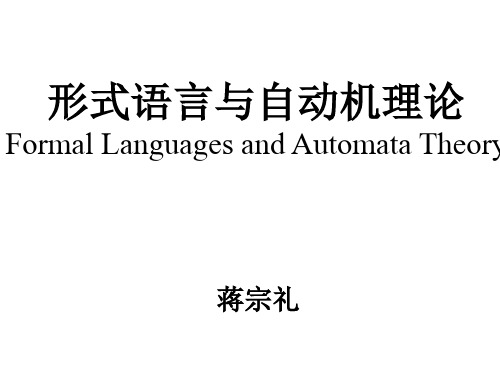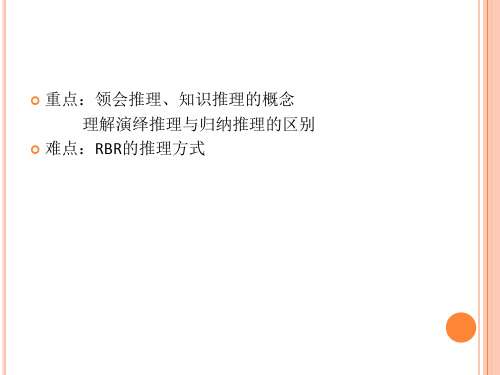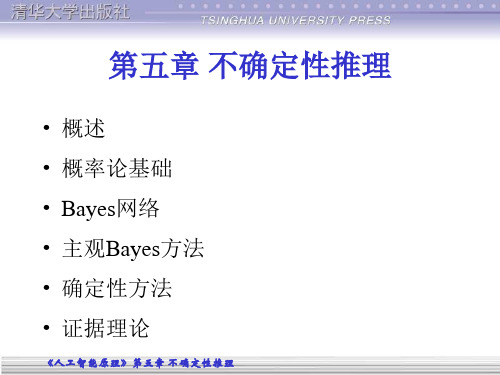第5章 形式化验证1
形式语言与自动机理论--第五章(蒋宗礼)

• CSL
– CSG、LBA。
教材及主要参考书目
1.蒋宗礼,姜守旭. 形式语言与自动机理论. 北京: 清华大学出版社,2003年 2. John E Hopcroft, Rajeev Motwani, Jeffrey D Ullman. Introduction to Automata Theory, Languages, and Computation (2nd Edition). Addison-Wesley Publishing Company, 2001 3. John E Hopcroft, Jeffrey D Ullman. Introduction to Automata Theory, Languages, and Computation. Addison-Wesley Publishing Company, 1979
f : 2
*
是正则代换,则f(L)也是 RL。 证明: 描述工具:RE。 对r中运算符的个数n施以归纳,证明f(r) 是表示f(L)的RE。
5.2 RL的封闭性
• 当n=0时,结论成立。 • 当n≢k时定理成立,即当r中运算符的个数 不大于k时:f(L(r)) = L(f®。 • 当n=k+1时,
5.1 RL的泵引理
故, δ(q0,a1a2…ak(ak+1…aj)i aj+1…am)=qm 也就是说, a1a2…ak(ak+1…aj)i aj+1…am∈L(M) u= a1a2…ak, v=ak+1…aj, w= aj+1…am uviw∈L
5.1 RL的泵引理
• 例 5-1 证明{0n1n|n≥1}不是 RL。 证明: 假设L={0n1n|n≥1} 是 RL z=0N1N 按照泵引理所述 v=0k k≥1 此时有, u=0N-k-j w=0j1N
5【中考复习】第五章:不等式(不等量关系)

二、不等式组结构和转换
1.
不等式组(结构)和意义
2.
解不等式
3.
分式不等式转换为不等式组
4.
绝对值不等式转换为不等式组
5.
不等式结构和数式结构分类
三、不等式和数量
1.
通过数量判断不等式取值范围
2.
不等式解求不等式组系数
3.
不等量关系的日常语言表达
四、中考真题(出题形式)
1、不等式的意义
● 画一个大于9面积的几何图形。
有最大值5/2,最大整数2
观察什么?
1)观察范围延伸方向;2)观察范围边界数量;
中考复习
5、代数式是否有最大最小值
通过数量范围找出这个范围内的最大(小)数量,根据不等式判断是否有最大最小值
例:a≤4,有最大值4
例:b≥5,有最小值5
例:c<4,无最大值,最大整数值3
例:d>5,无最小值,最小整数值6
方程和不等式的区别:
1、方程的解——具体的数量;不等式的解——数量范围
2、等式没有方向;不等式有方向
等式两边代数式交换,等式成立;不等式两边代数式交换,不等式不成立
例:3=(2+1) 交换正确:(2+1)=3
(2+2)>3 交换错误:3>(2+2)
中考复习
3x+4
≤
5
3、不等式性质(结构转换)
性质1:不等式两边同加(减)同一个代数式,不等式方向不变;
>、≥、<、≤
✓ 表示数量不相等的数学符号:
•
不等式的意义:
字母n表示所有大于9的数量的范围。
思维如何确定数量范围?
字母m表示所小于等于9的数量的范围。
第5章 身份认证_图文.ppt

第5章 身份认证
从安全的角度衡量,上述协议显然优于例5-1中的 认证协议。但上述认证协议中,没有说明口令在服务 器端的存放方法。如果解决不了口令的存放问题,该 协议显然不能用于大规模认证。
那么上述协议是否就安全了呢?协议的安全性衡 量是非常复杂的,这一方面需要对安全性进行精确的 定义,另一方面还要对具体协议进行理论上的证明。 很多使用多年、貌似安全的协议后来被证明是不安全 的。目前,安全协议的形式化证明方面主要有以下3 类研究方法,分别是:① 基于推理结构型方法(如 BAN逻辑);② 基于攻击结构性方法(如模型检测);③ 基于证明结构性方法(如串空间模型)。
IDU
RU
RS
Key MAC
Keyed Hash Function
MAC
图5-5 一个基于挑战-应答协议的口令认证方案
第5章 身份认证
在该认证协议中,口令即是key。假如用户向服务 器发出认证请求,服务器首先产生一个随机数(挑 战)RS送给用户。用户把自己的身份IDU和自己产生的 随机数RU连同RS一起作为自变量计算由Key控制的 Hash值MAC,然后把IDU、RU和MAC发给服务器(应 答)。服务器根据收到的IDU、RU和自己保留的RS重 新计算MAC,然后与收到的MAC进行比较验证。
第5章 身份认证
5.1.5 完整性校验和
认证中秘密信息的存放是有要求的,例如,在基于口令的认 证系统中,验证端不允许存储口令,只允许存储口令的完整性校 验和。
完整性校验和是由要加以保护的数据按照特定的方法计算出 来的数值。数据的完整性靠反复计算校验和来证明正确有效。如 果计算出来的数值与存储的数值相符,则说明数据没受到损害; 反之,则认为数据已经受到损害。为行之有效,校验和必定是数 据中每一位的函数。
第5章程序正确性证明

测试的原则
1. 应当 “尽早地和不断地进行软件测试” 。 2. 测试用例应由测试输入数据和对应的预期输出结果 组成。
3. 程序员应避免检查自己的程序。 4. 在设计测试用例时,应当包括合理的输入条件和不 合理的输入条件。
5. 充分注意测试中的群集现象。即测试后程序中残存 的错误数目与该程序中已发现的错误数目成正比。
白盒测试
此方法把测试对象看做一个透明的盒子,它允 许测试人员利用程序内部的逻辑结构及有关信息, 设计或选择测试用例,对程序所有逻辑路径进行测 试。
通过在不同点检查程序的状态,确定实际的状 态是否与预期的状态一致。因此白盒测试又称为结 构测试或逻辑驱动测试。
白盒测试…
软件人员使用白盒测试方法,主要想对程序模块进行 如下的检查:
但这是不可能的。
假设一个程序P有输入量X和Y及输出量Z。在字长为32位的计 算机上运行。若X、Y取整数,按黑盒方法进行穷举测试:
可能采用的测试数据组: 232×232=264
如果测试一组数据需要1毫秒,一年工作365×24小时, 完成所有测试需5亿年。
等价类划分 边界值分析 错误推测法 因果图
…黑盒测试
9)输入三个数,其中含有0 10)输入三个数,其中含有负数 11)输入三个数,其中含有非整数值 12)输入三个均为0的数 13)输入三个均为非法字符
列出各种产生的情况来测试的方法显然是黑盒子 方法。它不关心盒子内程序的具体逻辑,只是根 据程序功能来设计测试用例
程序测试的黑盒子方法常凭经验进行,在设计 测试用例时可以综合使用上述各种方法。在设 计测试数据时,我们应该考虑认为最易出错和 最易忽略的地方,进行重点测试。
包含的不同执行路径数达520条,对每一条路径进行 测试需要1毫秒,假定一年工作365 × 24小时,要想 把所有路径测试完,需3170年。
第5章知识推理分析课件

CBR基于人的这种认知过程:人们在求解新问题时,常常回 忆过去积累下来的类似情况的处理,通过对过去类似情 况处理的适当修改来解决新的问题,过去的类似情况及 其处理被用来评价新的问题及产生新的问题求解方案。
其他方法还包括基于原型的推理、基于框架的推理和 模糊推理等等。
难。
推理与知识表示方法直接相关,产生式规则表示方 法提供了最基本的推理模式。他与框架、谓词逻辑 等其他表示方法相结合,可提供功能更强、更灵活的 推理方法。
1.产生式系统的组成
产生式系统一般由三个基本部分组成:规则库、综合数 据库和推理机。它们之间的关系如下图所示。
2024/3/14 18
(1)规则库:
Then 不出交通事故(x)
正向推理示例
交通事故示例:
目标结论:李先生不出交通事故。 推理过程 (用规则的前提匹配事实)
R1: 年龄(李先生)小于等于55 and 年龄(李先 生)大于等于35 中年人(李先生) (F1:年龄=43)
R2: 中年人(李先生) 老练(李先生) R3: 中年人(李先生) 细心(李先生) R4: 老练(李先生)and 细心(李先生)and 有
搜索和匹配是推理机的两大基本任务。对于一个 性能良好的推理机,应有如下基本要求:
(1)高效率的搜索和匹配机制; (2)可控制性; (3)可观测性; (4)启发性。
5.1.3 知识推理的类型
从方式上分,可分为演绎推理和归纳推理; 从确定性上分,可分为确定性推理和不确定性推理; 从单调性上分,可分为单调推理和非单调推理。
目标状态
(事实条件) → (结论假设)
正向推理过程是:
搜索规则(知识)库,逐条检查规则的前 提在事实库中是否存在
形式化方法

两个用于转换的输入函数,用由位置指向转换的 箭头表示,它们是: I(t1)={P2,P4} I(t2)={P2} 两个用于转换的输出函数,用由转换指向位置的
箭头表示,它们是:
O(t1)={P1} O(t2)={P3,P3} 注意,输出函数O(t2)中有两个P3,是因为有两个 箭头由t2指向P3。
5.3.1 基本概念 Petri网包含4种元素:一组位置P、一组转换T、 输入函数I以及输出函数O。图5.5举例说明了Petri网 的组成。 其中, 一组位置P为{P1,P2,P3,P4},在图中用圆圈 代表位置。 一组转换T为{t1,t2},在图中用短直线表示转 换。
图5.5 Petri网的组成
数学作为软件开发工具的最后一个优点是,它提 供了高层确认的手段。可以使用数学方法证明,设计 符合规格说明,程序代码正确地反映了设计结果。
5.1.3
应用形式化方法的准则
为了更好地发挥这种方法的长处,下面给出应用 形式化方法的几条准则,供读者在实际工作中使用。 · 选择适用于当前项目的符号系统。 · 应该形式化,但不要过分形式化。通常没有必 要对系统的每个方面都使用形式化方法。 · 应该进行成本/效益分析。 · 需要有形式化方法的顾问。
6元组,其中每个谓词都是系统全局状态Y的函数。转
换函数T现在是一个从(J-F)×K×P到J的函数。现在的 转换规则形式如下: 当前状态〔菜单〕+事件〔所选择的项〕+谓词 下个状态。
5.2.2
电梯问题
为了说明在实际工作中怎样使用形式化的方法, 现在我们用有穷状态机技术给出电梯问题的规格说明。
果t2也被激发了,则令牌从P2中移出,两个新令牌被
J是一个有穷的非空状态集;
K是一个有穷的非空输入集; T是一个从(J-F)×K到J的转换函数; S∈J,是一个初始状态; FJ,是终态集。
05.形式化开发方法(1)-Petri网

目前流行的形式化开发方法
形式化规格说明建模 形式化验证 形式化程序求精
-软件工程讲义-
-7-
形式化规格说明建模
操作类
基于状态和转移
Petri网、有限状态机和状态图
描述类
基于数学公理和概念
基于逻辑的描述方法:命题线性时态逻辑(PLTL)、 一阶线性时态逻辑(FOLTL)、计算树逻辑(CTL) 基于代数的描述方法:Z语言、VDM和Larch
-软件工程讲义-5-
形式化开发方法发展历史
20世纪60年代末
形式化方法与非形式化大致同步 都是为解决当时出现的“软件危机”提出 一般认为是Floyd、Hoare和Manna等在程序正确性证明 方面的研究。但由于这些方法受程序规模的限制而未能 应用
20世纪80年代末
在硬件设计领域形式化方法的工业应用结果,又掀起了 软件形式化开发方法的学术研究和工业应用的热潮,建 立了一些较为成熟的方法和语言 如Petri网、statecharts、通信顺序过程、通信系统演算、 程序正确性证明、时态逻辑、模型验证、Z语言、 VDM 及Larch等
结构化和OO方法
使用了大量的自然语言。自然语言的二义性、不 完整和抽象层次的混杂等问题的解决,必然使开 发系统的质量不高、成本增加和进度拖长;尤其 对安全性或其他质量因素要求极高的软件,任何 微小的错误都可能带来灾难性的后果
形式化的方法
可以帮助软件开发人员开发出更为无二义性、完 整的和准确的需求规格说明,进而通过严格的验 证发现问题,以达到对软件质量、开发成本和开 发进度的有效控制
示例-四季系统Σ Petri网的定义 Petri网的基本原理-静态结构 Petri网的基本原理-动态特征 建模实例 特性分析 Petri网的特性分析方法 改进Petri网及其应用 时间网和随机网 从Petri网到程序结构的转换
第5章程序正确性证明精品PPT课件

x1>0∧ x2>0 ∧ y1>0 ∧y2>0 ∧ gcd(y1,y2)=gcd(x1,x2)
通路2:
P(x1,x2,y1,y2) ∧ y1<>y2 ∧ y1>y2 => P(x1,x2,y1-y2,y2) x1>0 ∧x2>0 ∧ y1>0 ∧ y2>0 ∧ gcd(y1,y2)=gcd(x1,x2) ∧ y1<>y2 ∧ y1>y2
程序正确性理论是十分活跃的课题,不仅可 以证明顺序程序的正确性,而且还可以证明非确 定性程序,以及并行程序的正确性。
程序正确性理论
程序设计的一般过程
程序正确性理论
程序功能的精确描述 1、程序规约:对程序所实现功能的精确描述,
由程序的前置断言和后置断言两部分组成。 2、前置断言:程序执行前的输入应满足的条件,
通路2:
若y1>y2, gcd(y1-y2,y2) = gcd(y1,y2) =gcd(x1,x2)
通路3:
若y2>y1, gcd(y1,y2)=gcd(y1,y2-y1) =gcd(x1,x2)
通路4:
若y1=y2,gcd(y1,y2) =gcd(x1,x2)=y1=y2=z P(x1,x2,y1,y2) ∧ y1=y2 => O(x1,x2,z)
I(x)=> P(x,0,1,1) x>0=> 0 ≤ x ∧ 1=(0+1) 2 ∧ 1=2*0+1
通路2:B->D->B
P(x,y1,y2,y3) ∧ y2≤x => p(x,y1+1,y2+y3+2,y3+2) y12≤x ∧ y2=(y1+1)2 ∧ y3 = 2y1+1 ∧ y2≤x => (y1+1) 2 ≤ x ∧
《人工智能》第5章学习智能体-概念学习概念学习

对于某类任务T和性能度量P,如果一个计算机程 序在T上以P衡量的性能随着经验E而自我完善,那 么我们称这个计算机程序在从经验E中学习
11
学习问题的标准描述
西洋跳棋学习问题
任务T:下西洋跳棋 性能标准P:比赛中击败对手的百分比 训练经验E:和自己进行对弈
手写识别学习问题
任务T:识别和分类图像中的手写文字 性能标准P:分类的正确率 训练经验E:已知分类的手写文字数据库
Humidity Normal
High High High
Wind Strong Strong Strong Strong
Water Warm Warm Warm Cool
Forecast Same Same Change Change
EnjoySport Yes Yes No Yes
29
概念学习任务
< , , , , , >
// 所有的样例都是反例
30
概念学习任务
形式化描述 已知 实例集X ▪ 每个实例x由6个属性描述,每个属性的取值范围已确定 假设集H ▪ 每个假设h描述为6个属性的取值约束的合取 (∩) 目标概念c ▪ 一个布尔函数,变量为实例,即: c:x->{1,0} 训练样例集D ▪ 目标函数(或目标概念)的正例和反例 求解 H中的一假设h,使对于X中任意x,h(x)=c(x)
问题产生器
以当前的假设作为输入,输出一个新的问题,供执行系统去 探索。
23
小结:设计一个学习系统
基本设计方法和步骤
Step1: 明确任务T、性能度量P Step2: 训练经验E Step3: 选择目标函数及其表示 Step4: 选择目标函数的学习算法 Step5: 最终设计
《形式化语言》课件

硬件设计:用于描述和验证硬 件设计的正确性和安全性
数学证明:用于描述和验证数 学定理的正确性和安全性
形式化语言的语法规则
语法规则的概述
形式化语言 的语法规则 是描述语言 结构的规则
语法规则包 括词法、句 法和语义规
则
词法规则描 述词的构成 和组合规则
句法规则描 述句子的构 成和组合规
则
语义规则描 述词的含义 和句子的含
语言实现的步骤与过程
确定语言目 标:明确语 言要实现的 功能和特性
设计语法和 语义:定义 语言的语法 规则和语义 解释
编写编译器: 实现语言的 语法分析和 语义分析
测试与调试: 对编译器进 行测试和调 试,确保其 正确性和稳 定性
发布与维护: 发布语言并 持续进行维 护和更新, 以满足用户 需求
形式化语言的实例分析
之一。
语义解释的方法
语法解释:通过 语法规则来解释 语义
语义解释:通过 语义规则来解释 语义
逻辑解释:通过 逻辑推理来解释 语义
模型解释:通过 建立模型来解释 语义
语义解释的过程
形式化语言的定义:一种用于描 述和验证计算机系统的数学语言
语义解释的方法:使用数学逻辑 和形式化方法进行描述和验证
添加标题
义
语法规则是 形式化语言 的基础,用 于描述语言 的结构和含
义
语法规则的构成要素
符号:用于表示语言中的各种元素,如字母、数字、运算符等 语法结构:描述符号的组合规则,如词法、句法等 语义:描述符号组合的意义,如表达式、语句等 语法分析:用于验证符号组合是否符合语法规则,如词法分析、句法分析等
语言特性的选择与确定
语言特性的选择:根据应用领域和需求选择合适的语言特性 语言特性的确定:根据语言特性的选择,确定语言的语法、语义和语用特性 语言特性的实现:根据语言特性的确定,实现语言的编译器、解释器或虚拟机 语言特性的验证:通过测试和验证,确保语言特性的实现符合预期
小学六年级数学下册第5章 数学广角及总复习 教案说课稿

结果:有可能摸出 2 个同色的球。 (2) 一次摸 3 个球,有几种情况?
5
抽屉原理”
第 1 课时
1.经历“抽屉原理”的探究过程,初步了解“抽屉原理”,会用“抽屉
原理”解决简单的实际问题。
2.通过操作发展学生的类推能力,形成比较抽象的数学思维。
3.通过“抽屉原理”的灵活应用感受数学的魅力。
经历“抽屉原理”的探究过程,初步了解“抽屉原理”。
理解“抽屉原理”,并对一些简单实际问题加以“模型化”。
学生思考——组内交流——汇报 师:为什么要先平均分?(组织学生讨论) 那么把 5 枝笔放进 4 个盒子里呢?把 6 枝笔放进 5 个盒子里呢?还用摆 吗? 把 9 枝笔放进 8 个盒子里呢?…… 你发现什么? 生 1:笔的枝数比盒子数多 1,不管怎么放,总有一个盒子里至少有 2 枝 铅笔。 2.解决问题。 (1)课件出示:5 只鸽子飞回 4 个鸽笼,至少有 2 只鸽子要飞进同一个鸽 笼里,为什么? 用平均分的方法,就能说明存在“总有一个鸽笼至少有 2 只鸽子飞进一个 个笼里”。 板书:5÷4=1……1 (二)教学例 2 1.出示题目:把 5 本书放进 2 个抽屉里,不管怎么放,总有一个抽屉里 至少有几本书? 把 7 本书放进 2 个抽屉里,不管怎么放,总有一个抽屉里至少有几本书? 把 9 本书放进 2 个抽屉里,不管怎么放,总有一个抽屉里至少有几本书? (留给学生思考的空间,师巡视了解各种情况) 2.学生汇报。 生 1:把 5 本书放进 2 个抽屉里,如果每个抽屉里先放 2 本,还剩 1 本, 这本书不管放到哪个抽屉里,总有一个抽屉里至少有 3 本书。 板书:5÷2=2 本……1 本(商加 1) 7÷2=3 本……1 本(商加 1) 9÷2=4 本……1 本(商加 1) 师:你能发现什么? 生 1:“总有一个抽屉里的至少有 2 本”只要用“商+1”就可以得到。 师:如果把 5 本书放进 3 个抽屉里,不管怎么放,总有一个抽屉里至少有 几本书? 生:“总有一个抽屉里的至少有 3 本”只要用 5÷3=1 本……2 本,用“商 +2”就可以了。 生:不同意!先把 5 本书平均分放到 3 个抽屉里,每个抽屉里先放 1 本, 还剩 2 本,这 2 本书再平均分,不管分到哪两个抽屉里,总有一个抽屉里至少
计算机科学导论-思想与方法 第3版 第5章

函数是程序设计的基础
程序定义了计算函数的算法。 而定义函数的方法又影响着程序语言的设计。 好的程序设计语言一般都便于函数的计算。
关系
每个关系对应于一个谓词;该谓词的定义域是由k元组组成 的集合,值域为{0, 1}。
二元关系:由有序对组成的集合。 对于每个有序对,称其第一个元素与第二个元素具有相应
集合的补
设I为全集,A为I的任意一子集,则将I–A则为A的补集。
表示为:A ={x|x∈I 并且 xA}。
求补集的运算称为补运算。
例5.4 若I= {x|–5﹤x﹤5}, A={x|0﹤x﹤1},求 A。 解:A = I–A = {x|–5﹤x﹤0∨1﹤x﹤5}
集合的运算
集合的乘积
等价关系
对于集合A上的任一二元关系R (即R A×A),如果R满足以下3 个条件,则称R为A上的一个等价关系:
自反性:对于集合中的每个元素a都有aRa; 对称性:对于集合中的任意两个元素a和b,aRb成立当且仅当bRa成
立; 传递性:对于集合中的任意元素a, b, c,如果aRb和bRc成立,则
练习
血缘关系是不是等价关系? 分析:血缘关系满足自反性和对称性,但不满足传递性,
因此不是等价关系。
“相似”关系 “平行”关系 “相等”关系 “”关系 “朋友”关系 “同学”关系
等价类
等价关系的一个重要应用在于对集合进行等价划分。
集合A上的一个等价关系R可以将A划分为若干个互不相交的 子集;
例5.5 若A={1,2,3},B={a,b},求A×B
解:A×B = { (1, a), (1, b), (2, a), (2, b), (3, a), (3, b)}
2024年学习笔记信息系统项目管理师(第四版)第五章-信息系统工程

第五章-信息系统⼯程1-软件⼯程1.1-架构设计1.软件架构为软件系统提供了一个结构、行为和属性的高级抽象,由构件的描述,构件的相互作用(连接体)、指导构件集成的模式以及这些模式的约束组成。
2.软件架构主要研究内容涉及软件架构描述、软件架构风格。
软件架构评估和软件架构的形式化方法等。
3.研究软件架构的根本目的是解决好软件的复用、质量和维护问题。
4.软件架构设计的一个核心问题是能否达到架构级的软件复用,也就是说,能否在不同的系统中使用同一个架构软件。
软件架构风格是描述某一个特定应用领域找那个系统组织方式的惯用模式。
5.通用软件架构:数据流风格、调用/返回风格、独立构件风格、虚拟机风格和仓库风格。
6.数据流风格:包括批处理序列和管道/过滤器两种风格。
7.调用/返回风格包括主程序/子程序、数据抽象和面向对象,以及层次结构。
8.独立构件风格包括进程通信和事件驱动的系统9.虚拟机⻛格包括解释器和基于规则的系统。
10.仓库⻛格包括数据库系统、⿊板系统和超⽂本系统。
11.在架构评估过程中,评估⼈员所关注的是系统的质量属性。
1.2-需求分析1.虚拟机⻛格包括解释器和基于规则的系统。
需求是多层次的,包括业务需求、⽤户需求和系统需求,这三个不同层次从⽬标到具体,从整体到局部,从概念到细节。
2.业务需求:指反映企业或客户对系统⾼层次的⼀个⽬标追求,通常来⾃项⽬投资⼈、购买产品的客户、客户单位的管理⼈员、市场营销部⻔或产品策划部⻔等。
3.⽤户需求:描述的是⽤户的具体⽬标,或者⽤户要求系统能完成的任务,⽤户需求描述了⽤户能让系统来做什么。
4.系统需求:是指从系统的⻆度来说明软件的需求,包括功能需求,⾮功能需求和设计约束。
5.质量功能部署QFD是⼀种将⽤户要求转化成软件需求的技术,其⽬的是最⼤限度地提升软件⼯程过程中⽤户的满意度。
为了达到这个⽬标,QFD将需求分为三类,分别是常规需求、期望需求和意外需求。
6.需求过程主要包括需求获取、需求分析、需求规格说明书编制、需求验证与确认等。
软件工程中的可信验证与认证

帮助开发人员确保应用安全性
银行系统信息安全认证实践
静态代码分析和模 型验证技术
保证系统的稳定性 和可靠性
持续改进安全措施
应对不断演变的网 络安全威胁
定期安全扫描和漏 洞修复
确保系统免受黑客 攻击和数据泄露的
威胁
结语
可信验证与认证在软件工程中扮演着重要角色, 不仅保障用户数据安全,也提升系统可信度。 不同领域的认证实践为我们提供了宝贵的经验,
安全认证技术
安全评估和认证
安全认证技术是通 过认证机构对软件 系统进行安全评估
和认证的技术
符合安全标准和法规
安全认证技术可以 确保软件系统符合 相关的安全标准和
法规
提供信任和保障
安全认证技术可以 为软件系统的用户
提供信任和保障
总结
可信验证与认证技术在软件工程中起着重要作 用,静态代码分析、动态测试技术、模型验证 方法和安全认证技术都是为了确保软件系统的 可信度和安全性。通过这些技术的应用,可以 提高软件系统的质量和可靠性,同时确保用户
数据和系统的安全。
第3章 可信验证与认证工具
●03
Coverity
静态检查工具
SonarQube
代码质量分析工具
PMD
代码规范检查工具
静态代码分析工具
动态测试工具
JUnit
单元测试框架
Postman
API测试工具
Selenium
Web自动化测试 工具
模型验证工具
SPIN
Alloy
TLA+
NuSMV
以提高软件系统的可信度和安全性。
工具种类繁多
静态、动态、模型、认证
提高软件可信度
检测问题、验证模型、解决漏洞
人工智能导论_第5章

i
i
《人工智能原理》第五章 不确定性推理
i
概率论基础(贝叶斯定理 )
• 设 A , B1 , B2 , … , Bn 为 一 些 事 件 , P(A)>0 , B1 , B2 , … , Bn 互 不 相 交 , P(Bi)>0, i=1, 2, …, n,且 P(B ) 1 ,则对 于k=1, 2, …, n,
n n
n n
,
n
n
P( B )
《人工智能原理》第五章 不确定性推理
An B
P( A )
n
概率论基础(统计概率性质 )
• 对任意事件A,有 0 P( A) 1 • 必然事件Ω 的概率P(Ω ) =1,不可能事件 φ 的概率P(φ ) = 0 P(~ A) 1 P( A) • 对任意事件A,有 P( A ) P( A ) P( A ) ... P( A ) • 设事件 A1 , A2 , …An ( k≤n )是两两互 不相容的事件,即有,则 • 设A,B是两事件,则
《人工智能原理》第五章 不确定性推理
第五章 不确定性推理
• 概述 • 概率论基础 • Bayes网络 • 主观Bayes方法 • 确定性方法 • 证据理论
《人工智能原理》第五章 不确定性推理
概述
• 不精确思维并非专家的习惯或爱好所至, 而是客观现实的要求。
–很多原因导致同一结果 –推理所需的信息不完备 –背景知识不足 –信息描述模糊 –信息中含有噪声 –规划是模糊的 –推理能力不足 –解题方案不唯一
0 P( A) 1 P () 1 P( ) 0 –若二事件AB互斥,即,则 P( A B) P( A) P( B)
PM讲义-第5章 最弱前置谓词和程序语言的语义

5.2 基本语句的语义-前言
前言:
用wp定义一个小程序设计语言L,此语言的 表达式只有整型和布尔型两类,说明语句采 用类Pascal的形式,其基本执行语句有空语 句(Skip)、赋值语句、选择语句、循环语 句。 令记号“=df” 为定义符,读做“定义为”
5.2 基本语句的语义-空语句
1.空语句(Skip) Skip语句表示什么事都不做,相当于空语句。 其定义如下:
5.2 基本语句的语义-顺序复合
wp(“s1;s2”,Q) =df wp(“s1”,wp(“s2”,Q))
例: wp(“t:=x; x:=y; y:=t”, x=u2 ∧y=u1)
=wp(“t:=x; x:=y”,wp(“y:=t”, x=u2 ∧y=u1)) =wp(“t:=x; x:=y”, x=u2 ∧t=u1) =wp(“t:=x”,wp(“x:=y”, x=u2 ∧t=u1)) =wp(“t:=x”,y=u2 ∧t=u1) = y=u2 ∧x=u1
例8:wp(“x,y:=x-y,y-x”,x+y=c) = (x-y+y-x = c) = (0 = c)
5.2 基本语句的语义-顺序复合
3. 顺序复合
考虑由两个语句s1和s2构成的复合语句“s1;s2”的语 义: 定义5: wp(“s1;s2”,Q) =df wp(“s1”,wp(“s2”,Q))
H2(Q) = H0(Q) ∨wp(IF, H1(Q) )
5.2 基本语句的语义
wp(DO, Q)可以定义为这样一个状态集合: DO从其中任一状态开始执行,必须经过有限次 迭代后终止于满足Q的状态。于是: 定义7:
wp(DO, Q) =df ( k: k≥0 : Hk(Q) )
第05章面向对象分析

经过初步筛选后,剩下的类与对象有:
手表、按钮、显示屏、电池、时间。
2 按钮 1 简单手表 1 1 时间
1 显示屏
1
1 电池
1
图5-8 电子表元素的UML类图
三、定义属性和方法
问题域中的事物的特征可以区分为静态特征和动态特征, 静态特征可以通过一组数据来表示,而动态特征则可以通过一 系列操作来表达。面向对象方法用对象来抽象问题域中的事物, 相应的对象属性和服务则与事物的静态特征和动态特征相对应。
第5章
面向对象分析
教学目的、要求,重点、难点
目的要求:使学生了解面向对象的分析过程,需求 陈述的书写,掌握建立对象模型、动态模型、功能 模型方法和步骤。 教学重点:建立对象模型、动态模型、功能模型的 方法和步骤。 教学难点:建立对象模型、动态模型、功能模型的 方法和步骤 讲授内容:面向对象的分析过程,需求陈述的书写, 建立对象模型、动态模型、功能模型方法和步骤。
电子表
构造对象模型的第一 步是标出来自问题域的相 关对象类。对象包括物理 实体和概念,所有类在应 用中都必须有意义,在问 题陈述中,并非所有类都 是明显给出的。有些是隐 含在问题域或一般知识中 的。
读时间
设置时间 手表用户 更换电池 手表修理工 图5-6 电子表的UML用例图
二、发现对象的方法 类-&-对象是在问题域中客观存在的,系统分 析员的任务,就是通过分析找出这些类-&-对象。 1、找出侯选的类-&-对象 客观事物可以分为五类: 1)可感知的物理实体;(飞机,汽车,书…) 2)人或组织的角色;(医生,教师,雇主,计算机系) 3)应该记忆的事件;(飞行,演出,交通事故…) 4)两个或多个对象的相互作用,通常具有交易或接触 的性质;(购买,纳税,结婚…) 5)需要说明的概念;(政策,保险政策,版税法…) 在分析所面临的问题时,可以参照上述五类事物, 找出在当前问题域中的侯选类-&-对象。
软件工程导论 第4章 形式化说明技术1

形式化说明技术按照形式化的程度,可以把软件工程使用的方法划分成非形式化,半形式化和形式化3类。
用自然语言描述需求规格说明,是典型的非形式化方法。
用数据流图或实体—联系图建立模型,是典型的半形式化方法。
所谓形式化方法,是描述系统性质的基于数学的技术,也就是说,如果一种方法有坚实的数学基础,那么它就是形式化的。
4.1 概述4.1.1 非形式化方法的缺点用自然语言书写的系统规格说明书,可能存在矛盾、二义性、含糊性、不完整性及抽象层次混乱等问题。
所谓矛盾是指一组相互冲突的陈述。
例如,规格说明书的某一部分可能规定系统必须监控化学反应容器中的温度,而另一部分(可能由另一位系统分析员撰写)却规定只监控在一定范围内的温度。
如果这两个相互矛盾的规定写在同一页纸上,自然很容易查出,不幸的是,它们往往出现在相距几十页甚至数百页的两页纸中。
二义性是指读者可以用不同方式理解的陈述。
例如,下面的陈述就是具有二义性:“操作员标识由操作员姓名和密码组成,密码由6位数字构成。
当操作员登录进系统时它被存放在注册文件中。
”在上面这段陈述中,“它”到底代表“密码”还是“操作员标识”,不同的人往往有不同的理解。
系统规格说明书是很庞大的文档,因此,几乎不可避免地会出现含糊性。
例如,我们可能经常在文档中看到类似下面这样的需求:“系统界面应该是对用户友好的。
”实际上,这样笼统的陈述并没有给出任何有用的信息。
不完整性可能是在系统规格说明中最常遇到的问题之一。
例如,考虑下述的系统功能需求:“系统每小时从安放在水库中的深度传感器获取一次水库深度数据,这些数值应该保留6个月。
”假设在系统规格说明书中还规定了某个命令的功能:“AVERAGE命令的功能是,在PC机上显示由某个传感器在两个日期之间获取的平均水深。
”如果在规格说明书中对这个命令的功能没有更多的描述,那么,该命令的细节是严重不完整的,例如,对该命令的描述没有告诉我们,如果用户给定的日期是在当前日期的6个月之前,那么系统应该做什么。
- 1、下载文档前请自行甄别文档内容的完整性,平台不提供额外的编辑、内容补充、找答案等附加服务。
- 2、"仅部分预览"的文档,不可在线预览部分如存在完整性等问题,可反馈申请退款(可完整预览的文档不适用该条件!)。
- 3、如文档侵犯您的权益,请联系客服反馈,我们会尽快为您处理(人工客服工作时间:9:00-18:30)。
A Brief History of FV
Late 80s and early 90s:
Deal with state explosion OBDD Abstraction Modularity Symmetry
A Brief History of FV
Verification:Are we building the prodict right? Validation:Are we building the right prodict?
Simulation vs. Emulation vs.Test
Simulation(模拟 performed on the model 模拟): 模拟 Emulation(仿真 performed on prototyping 仿真): 仿真 Test(测试 performed on the actual product 测试): 测试 (manufacturing test)
Safety critical systems Commercially critical systems Mission critical systems
What is verification?
Theoretically, verification means proof of correctness
Verification vs Validation
Verification: is the procees checking if the product is built correctly according to the specification. Validation: is the procees that ensures that the product meets the expectation of the user. In Boehm word:
Small tricky(技巧的) programs manually annotated and proved
A Brief History of FV
1970s: Progress in automated deduction related to program verification
1973: [Boyer Moore] Computational Lisp 1975: [Nelson Oppen] Decision procedures for combination logic theories 1976: [D Gordon ] Higher Order Logic theorem proving (LCF) 1977: [F Pnueli] introduces (linear) temporal logics(LTL) as a formalism to reason about reactive systems
Chapter 5 Formal Verification
5.1 Overview 5.2 Theorem proving 5.3 Model Checking
5.1 Overview
What is Verification? What is formal Verification Formal Verification Methods Formal Verification Process A Brief History of FV
What is formal Verification?
Formal verification means to apply mathematical arguments to prove the correctness of systems Formal means two things:
A mathematical (not English) specification An exhaustive(彻底的) verification method (not simulation)
Automatic: Model Checking Semi-automatic (deductive/theorem proving)
Practically, it mainly attempts to increase reliability:
Automated systematic debugging VERY good at finding errors!
Formal Verification Process
1. Modelling
What the system actually does Expressed as a set of predicates, or as an automaton
2.
What the system ought to do Expressed in an assertion language, e.g., boolean logic,LTL,CTL,µ-calculus,…
A Brief History of FV
1960s: [Floyd,McCarthy] Program verification
Partial vs total correctness
1970s: [Hoare, Dijkstra] Logics for programs, axiomatic semantics (connect programs to logic), logical transformations for program constructs
Determine
Can we construct a proof for S (from A) in calculus C?
What is Theorem Proving?
Logic = Syntax + Semantics + Calculus TP = Proof-search in C (Huge search problem) Correctness and completeness of Calculi are essential properties Calculus = Non-deterministic Algorithm Central problem in TP: How to implement a non-deterministic algorithm efficiently on a deterministic machine
“State Explosion”Problem
Formal Verification Process
Formal Verification process consist of three parts:
1.A framework for Formal modeling systems some kind of modeling language 2.A Formal specification language for describing the properties to be verified 3.A Formal verification method for establishing if the description of the system satisfies the specification
Formal Verification Methods
Deductive演绎verification
Automated theorem proving
Interactive verification
Semi-automated theorem proving Formal Verification
What is Verification?
Verification: verifying the correctness of products
Hardware, software, embedded control systems, network protocols, …
It is most obvious in
a formal language (or logic) L a calculus C for this language (= set of rules) a conjecture (猜想)S and a set of assumptions or axioms A in the language L
By 1990s: Basic theoretical problems worked out 1990s: Emphasis on infinite state systems
Real time systems (timed automata) Embedded systems (hybrid automata) Models with stacks, queues, …(ADT)
Difficult and time consuming
for critical applications only
Formal Verification Methods
Interactive verification Analysis reduces to proving a theorem in a logic Uses interactive theorem prover(ITP) Requires more expertise
A Brief History of FV
1981: [Clarke, Emerson and Quielle Sifakis] independently discover finite state temporal logic model checking
Applied to digital circuits
